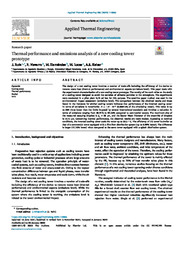Por favor, use este identificador para citar o enlazar este ítem:
https://hdl.handle.net/11000/35367Registro completo de metadatos
| Campo DC | Valor | Lengua/Idioma |
|---|---|---|
| dc.contributor.author | Ruiz Ramírez, Javier | - |
| dc.contributor.author | Navarro Cobacho, Pedro | - |
| dc.contributor.author | Hernández, Mónica | - |
| dc.contributor.author | Lucas Miralles, Manuel | - |
| dc.contributor.author | Kaiser, Antonio S. | - |
| dc.contributor.other | Departamentos de la UMH::Ingeniería Mecánica y Energía | es_ES |
| dc.date.accessioned | 2025-01-28T09:16:35Z | - |
| dc.date.available | 2025-01-28T09:16:35Z | - |
| dc.date.created | 2022 | - |
| dc.identifier.citation | Applied Thermal Engineering | es_ES |
| dc.identifier.issn | 1873-5606 | - |
| dc.identifier.issn | 1359-4311 | - |
| dc.identifier.uri | https://hdl.handle.net/11000/35367 | - |
| dc.description.abstract | The design of a wet cooling tower involves a number of trade-offs including the efficiency of the device to remove waste heat (thermal performance) and environmental aspects (emissions level). This paper deals with the experimental characterisation of a new cooling tower prototype. The novelty of the work relies on the study of a cooling tower designed to avoid the emission of airborne particles to the atmosphere. The experiments were conducted in a pilot plant built ad hoc for this purpose. The sensitive paper method was used in the environmental impact assessment (emissions level). The comparison between the obtained results and those found in the literature for similar cooling towers indicates that performance of the inverted cooling tower in terms of emissions is remarkable: (0.00015% of the circulating water). This value is up to 300 times lower than the limits imposed by several international standards and involves a reduction in terms of emissions ranging from 40.21% to 82.54% compared to commercial towers. The maximum size of the measured escaping droplets is = 50 m, and the Sauter Mean Diameter of the ensemble of droplets is m. Concerning thermal performance, the observed results are more modest. Operating at nominal conditions, the inverted cooling tower cools the water up to 33.5 °C. The efficiency of the tower is similar to that of a commercial tower equipped with a film-flow distribution system (up to 6.98% better). The difference is larger (41.16% lower) when compared to the same tower equipped with a splash distribution system. | es_ES |
| dc.format | application/pdf | es_ES |
| dc.format.extent | 10 | es_ES |
| dc.language.iso | eng | es_ES |
| dc.publisher | Elsevier | es_ES |
| dc.relation.ispartofseries | 206 | es_ES |
| dc.rights | info:eu-repo/semantics/openAccess | es_ES |
| dc.rights.uri | http://creativecommons.org/licenses/by-nc-nd/4.0/ | * |
| dc.subject | Cooling tower | es_ES |
| dc.subject | Thermal performance | es_ES |
| dc.subject | Merkel | es_ES |
| dc.subject | Drift | es_ES |
| dc.subject.other | CDU::6 - Ciencias aplicadas::62 - Ingeniería. Tecnología::621 - Ingeniería mecánica en general. Tecnología nuclear. Electrotecnia. Maquinaria | es_ES |
| dc.title | Thermal performance and emissions analysis of a new cooling tower prototype | es_ES |
| dc.type | info:eu-repo/semantics/article | es_ES |
| dc.relation.publisherversion | https://doi.org/10.1016/j.applthermaleng.2022.118065 | es_ES |

Ver/Abrir:
2022 ATE 206.pdf
1,75 MB
Adobe PDF
Compartir:
 La licencia se describe como: Atribución-NonComercial-NoDerivada 4.0 Internacional.
La licencia se describe como: Atribución-NonComercial-NoDerivada 4.0 Internacional.
.png)